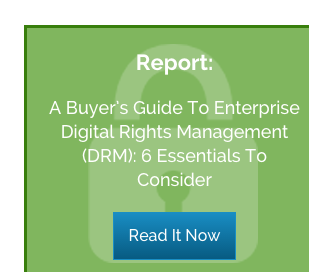Vaultize becomes the first solution provider to integrate enterprise digital rights management (eDRM aka enterprise information rights management) with enterprise file sync & share (EFSS), mobile file sharing and mobile content management (MCM). Seamless integration of rights management with enterprise mobility further strengthens the position of Vaultize as the leader in enterprise file security - giving enterprise IT end-to-end security, control and visibility, while providing consumer-like user experience to end-users.

Earlier, company-owned devices represented the majority of endpoints but over last few years the enterprise mobility trend has picked up. In the coming years, it is expected that there will be far more mobile devices (including bring-your-own-device (BYOD)) than laptops/desktops accessing and sharing the corporate data as a normal workflow (and even beyond corporate firewalls). Hence, Vaultize’s focus on end-to-end file security for enterprise mobility through enterprise rights management and mobile content management, is a major differentiator for security conscious and regulated verticals like Banking, Insurance & Financial (BFSI), Pharma, Media and Government.
In today’s mobile world, traditional perimeter-based security controls and enterprise mobility management (EMM) controls are insufficient to meet the enterprise security challenges. Top enterprise mobility management players including MobileIron, AirWatch, IBM MaaS360 and Good added significant features over the last few years trying to form a complete mobility solution. But they are still far away from ensuring 100% security of corporate data when the files move beyond the managed devices and get shared with the third-party.
Content in mobile world is difficult to lockdown without security controls travelling with the content itself. Vaultize addresses this through its patent-pending Micro-containerization technology, which is agnostic to file-formats and provides end-to-end file security. In this approach to enterprise digital rights management, Vaultize embeds access rights in the document itself such that it is only usable by the authorized recipients in compliance with DRM protection settings.
Vaultize’s DRM allows enterprise IT to automatically apply access rights to the shared files as part of automated policy enforcement. Through this, access to shared documents can be controlled and permissions to open, view, download, print, copy-paste, forward and edit those documents can be managed (and even revoked). DRM policies are automatically applied when the files are shared by document-owners through Outlook and Vaultize’s secure link sharing (including from mobile devices). The policies are uniformly applied across all end-users - irrespective of what devices they use – not only company managed PCs (Windows or Mac) but also BYOD smartphones and tablets (managed through an EMM solution).
Vaultize provides an easy and elegant mobile-first user experience for VPN-free access to enterprise content repositories (file servers) and mobile file sharing on iOS and Android devices. Vaultize mobile apps have built-in mobile content management that allows corporate IT to prevent data loss, security and compliance breaches by controlling what end-users can do with corporate data through a built-in document editor for MS Office editing and PDF annotation. With today’s announcement, Vaultize’s DRM now integrates with mobile content management such that files shared through Vaultize mobile apps stay DRM-protected even after they are downloaded by the recipient on a device not under control of the company IT. In addition to the protection, the embedded DRM enables detailed tracking and auditing of shared files wherever they go – independent of location, device and user.
The key features of DRM with mobile file sharing include:
- Access rights – IT and document-owner can control who can view, edit, print, copy-paste, forward and download the documents or the information contained in them
- Location control – IT can control geo-locations and IP ranges from where the recipient can access the shared data
- Expiration – IT and document-owner can set automatic expiration on the DRM-protected data
- Revoking rights – At any time, IT and document-owner can remotely revoke the permissions/rights for accessing the shared documents, even after those are downloaded by a recipient on his own device
- MCM Controls – Through mobile content management policy, IT can control the use of built-in editor for MS office and PDF annotation by controlling the copy-paste, printing and moving to other mobile apps
- Secure Online Document Viewer – The viewing of shared documents by third-parties can be restricted to read-only access through a secure web-based online document viewer, with full control on printing, copy-paste and screenshots
- Digital Watermarking – With the online document viewer, watermarks (like logo or copyright texts) can be added to each page of the document to discourage printing, screen capture or photo capture. This watermarking has options for embedding text, image, email, IP of share link recipient
- Watermarked downloads – Based on IT policy, downloads of shared files can be restricted to watermarked PDF
- Auto updates – The documents can be kept (based on the option at the time of sharing) in sync such that they are auto updated whenever the sender make changes
- Device Lockdown – IT and document-owner can decide to lockdown a shared file to a device of the recipient as well as the limit on the number of accesses
- File Types – The micro containerization allows control over MS Office and PDF documents
- Tracking – The usage of a file is completely tracked by IT and document-owner such that an audit trail of activities like opening, sharing, viewing, editing and forwarding is maintained at the level of file, individual user and location

